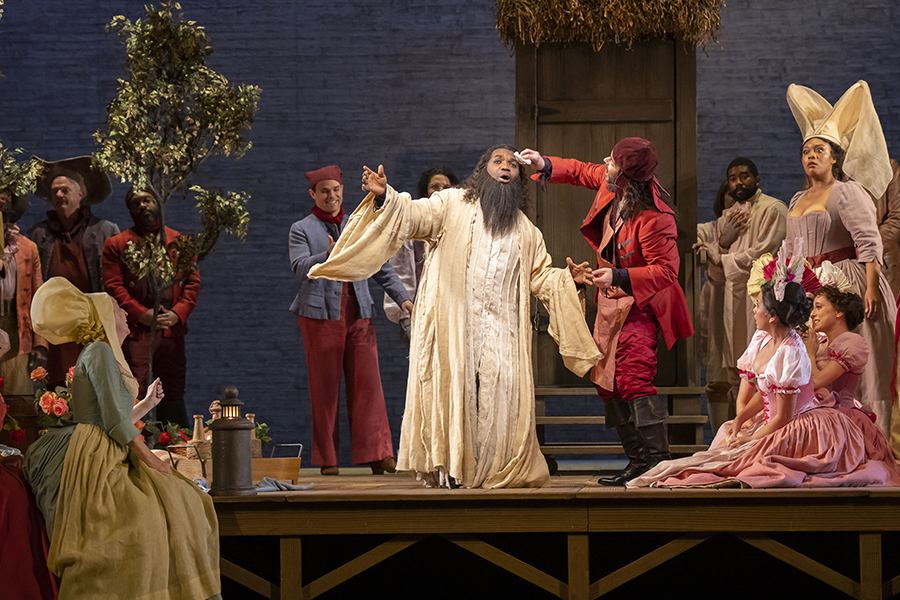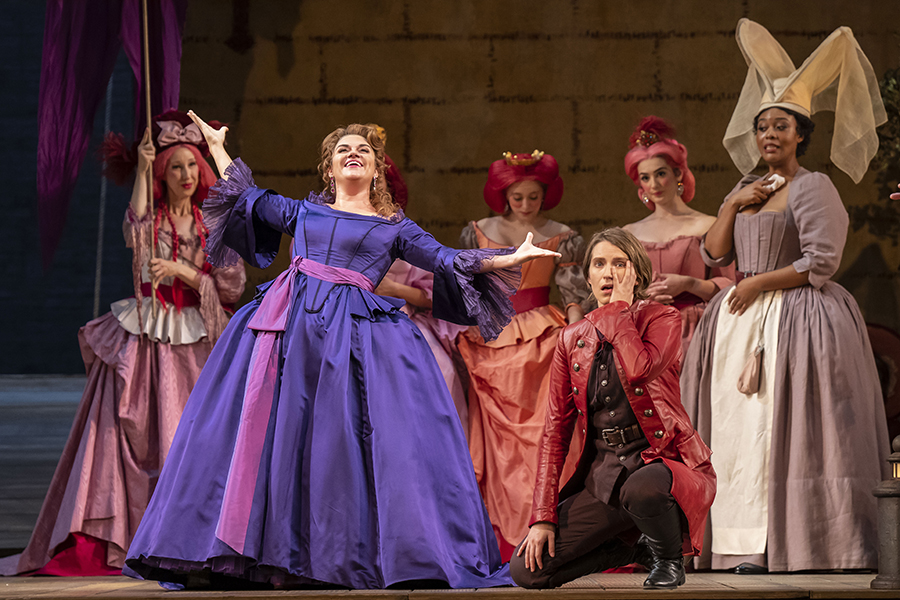November 04, 2022
Seriously funny
Enrique Mazzola could write the book on taking the operatic comedies of Gioachino Rossini seriously.
After all, the music director of Lyric Opera of Chicago has been applying his stylistic insights and interpretive authority to the genre of bel canto throughout his career on the podium.
Having previously presided over Lyric productions of such familiar bel canto staples as Gaetano Donizetti’s The Elixir of Love (2021/22) and Lucia di Lammermoor (2016/17), as well as Vincenzo Bellini’s I puritani (2017/18), the Italian maestro is about to add a lesser-known gem from the Rossini canon to his Chicago repertoire—the infrequently performed Le Comte Ory (1828), in its belated Lyric premiere.
Written for the Paris Opera and sung in French, Rossini’s third comic opera is a delectable romp of amorous pursuit and antic masquerades. It demands nothing less than a superbly virtuosic singer who can toss off the high-wire leaps, trills, roulades, and the other florid vocal gymnastics of the title role without breaking a sweat, all the while impersonating several figures, including a nun. The vocal challenges faced by the leading soprano, mezzo-soprano, and baritone are not exactly child’s play, either.
Lyric Opera has gone to the mat in its casting of the brilliant American tenor Lawrence Brownlee as the libidinous young nobleman Count Ory, whose attempt to ensnare the virtuous Countess Adèle (soprano Kathryn Lewek) finds him donning a nun’s habit to gain entrance to her castle during the Crusades. Kathleen Smith Belcher is Lyric’s revival director, remounting director Bartlett Sher’s lively and inventive, Metropolitan Opera production for these Chicago performances.
Preparing Le Comte Ory for performance demands from the conductor a skill set rather different from preparing a more conventional Rossini comedy such as Il barbiere di Siviglia, Mazzola said in a recent interview. He has resided over performances of the work in Japan, Italy, and elsewhere; of the Rossini comic operas, only Barbiere has enlisted his pitside services more often.
“Le Comte Ory is deliziosa, a delicious plate of pasta — witty, charming, and seductive,” Mazzola enthuses. “This is an opera you must schedule years in advance, and only if you have the right tenor for the title role. We have the very talented Larry Brownlee, one of fewer than a handful of Rossini Counts in the world.
“I am very proud we are performing the original source edition, newly published by Bärenreiter, which is very precise about the articulation of the instruments and voices,” he adds. “Many opera houses still use the old 1820s edition, which is full of mistakes. Ours will be one of the most accurate productions of Le Comte Ory in the operatic landscape.”

Lawrence Brownlee as Ory, Joshua Hopkins as Raimbaud, and Zoie Reams as Ragonde in Lyric's 2022/23 production of Le Comte Ory.
Audience members will immediately take to Rossini’s final comic opera, Mazzola predicts, not only for its vocal splendors but also for the witty, colorful, perfectly crafted orchestral writing that frames the vocal lines. How, in the maestro’s view, does the composer structure his arias, duets, and ensembles?
“Structurally, these numbers contain a lot of bel canto-istic space — they never should be taken too fast,” he observes. “They are very cantabile, in a way that’s quite unusual for Rossini. The French language adds a very natural, seductive charm to the comedy. And the fast cabalettas that end the acts require the orchestra to make a very virtuosic contribution to their musical development.”
The challenges are different for the singers. “Singing the slow parts is all about ornamentation, variation, the ability to sustain and support a linear phrase — you need not only speed but beauty of line,” Mazzola notes. “And very athletic voices are required when the music speeds up, with super-fast lines and vocal jumps of eight or ten notes.”
Given its problematic birth, Le Comte Ory should have turned out to be a musical and dramatic muddle.
The libretto began life as a one-act vaudeville play written in 1817 by Eugène Scribe and Charles-Gaspard Delestre-Poirson, based on a Crusaders’ ballad from Picardy about Count Ory and his followers, who disguise themselves as nuns to gain entry to the castle of Formoutiers so that Ory can try to win the affections of the Countess while her brother is away at the Crusades. For Rossini, Scribe added a prefatory act that recounts Ory’s initial attempt to breach the Countess’s defenses.
Six musical numbers from Il viaggio a Reims (1825), an operatic entertainment Rossini wrote (in Italian) to celebrate the coronation of King Charles X in France, were recycled into the score of Ory. So artfully did Rossini adapt the self-borrowed numbers to their new dramatic context that the amalgam works beautifully in every respect. When Le Comte Ory had its premiere at the Paris Opera in 1828, it was rightly praised as one of Rossini’s most seamless and sophisticated inspirations.
How, then, did the sound, rhythm, and phrasing of spoken French inspire Rossini musically?
“I’m not sure it was an inspiration,” Mazzola replies. “We must remember that, at the time, Paris was the main opera house of the world: Rossini, Bellini, Donizetti, and Verdi all needed to have their works performed at the prestigious Opera. That meant adapting to a different language. But, in fact, the French language created problems for those composers. Fast, syllabic singing works perfectly well in Italian, because we have very clear vowels. But sung French requires the composers to slow things down.
“And there’s another point — in the Italian school, the recitatives always follow the timing of the words. When sung in French, the rhythm of the recitative is written out, and you have to follow it. So when you perform Il viaggio a Reims and Le Comte Ory, they sound different, with different tempi and different recitative arrangements."
Only a single piece in Act I of Ory is entirely new — the duet for the Count and his page, Isolier (sung by mezzo-soprano Kayleigh Decker, an alumna of Lyric’s Ryan Opera Center). And, the situation is almost entirely reversed in Act II, for which Rossini borrowed only two compositions from Il viaggio.
“It’s very peculiar for Rossini to reuse his own material; still, Le Comte Ory is not the only example of this,” Mazzola observes, citing the composer’s 1816 La gazzetta (The Newspaper), a comic pastiche that includes pieces from his earlier stage successes Barbiere, L’Italiana in Algeri, Il turco in Italia, and La Cenerentola.
Le Comte Ory, Mazzola points out, is a prime example of the time-honored Italian theater tradition of travestimento — the comedy of disguise.
“Comte Ory and Donizetti’s Don Pasquale are the two big examples of this type of masquerade comedy, from the age of bel canto to its culmination in Verdi’s Falstaff in 1893,” he observes. “It’s one of the reasons why I love this opera so much. In my mind, whenever I conduct Le Comte Ory, I draw parallels with Barbiere, because in that comedy Count Almaviva enters Don Bartolo’s house twice to declare his amorous intentions to a woman. And he is disguised both times, like the Count in Ory.”

Kathryn Lewek as Adèle, Kayleigh Decker as Isolier, and Zoie Reams as Ragonde in Lyric's 2022/23 production of Rossini's Le Comte Ory.
The University of Chicago musicologist and Rossini scholar Philip Gossett, in his essay accompanying the 1989 Philips recording of the opera, writes that the jewels of the score are the pieces Rossini prepared directly for Le Comte Ory.
These include the lusty drinking song of the quartet of pilgrim women — Ory and his men in disguise — who have begged “the noble châtelaine” of the castle for refuge from the wicked Count; once they are inside the castle, their carousing alternates with the pseudo-devout, unaccompanied prayer of the quartet, sung whenever they realize they are being overheard.
Another highlight, in the late Gossett’s view, is the exquisite trio, “Á la faveur de cette nuit,” in which Ory solicits Isolier by mistake in the dim light of the Countess’s boudoir. Gossett wrote of the “nocturnal and insinuating quality” of the opening section, “its delicate orchestral shading, its erotic chromaticism (both structural and melodic), the shifting pairing of its voices.” The dramatic situation here recalls that of Act IV of Mozart’s Le nozze di Figaro, even as the music harkens to Mozart in its delicacy.
No wonder that Hector Berlioz, no great fan of Italian art, considered the trio to be Rossini’s masterpiece. Indeed, the French composer went on to praise the opera as a whole as “a collection of diverse beauties which, if divided up ingeniously, would suffice to make the fortune of not one, but two or three operas.”
Mazzola, for his part, is hardly less unstinting in his estimation.
Le Comte Ory, the Maestro says, is “the summa — the summation, the ne plus ultra — of Rossinian vocal virtuosity.”

